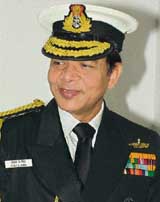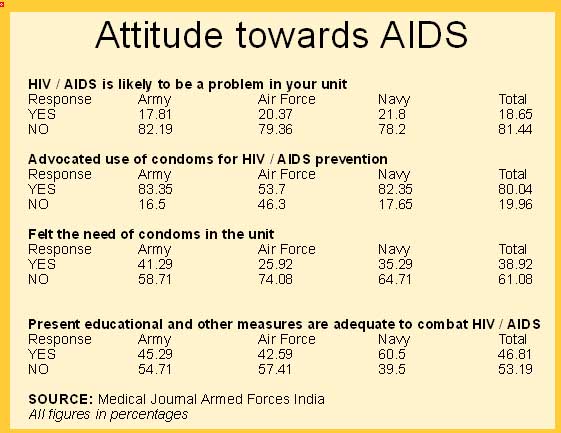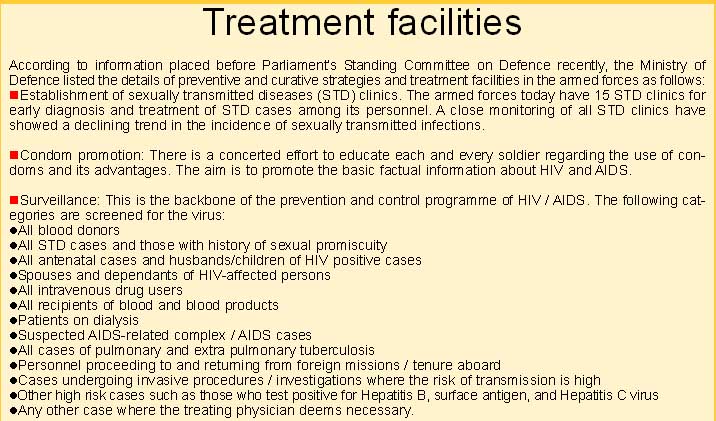|
Army’s fight against AIDS
The armed forces have waged a tough battle against AIDS among its personnel. Thanks to a number of measures undertaken to combat HIV on a war-footing, the incidence of the life-threatening disease has declined sharply in the three services, reports
Vijay Mohan

“Getting affected by the HIV virus is no crime, but hiding it is. Personnel can face punishment if they fail to disclose visits to sex workers. The services are trying to remove the stigma attached to the disease. We are sensitising officers and jawans about the dreaded disease, with bi-monthly lectures, slide-shows and video presentations.”
Surgeon Vice Admiral V.K. Singh, Director General, AFMS |
Even
as AIDS and HIV infection assumes epidemic proportions in the
country, the armed forces appear to have controlled the spread
of the deadly disease amongst its rank and file. In the year
2006, there was no case of AIDS reported in the defence
services. Besides, proactive measures adopted by the forces has
resulted in the number of military personnel testing positive
for HIV dropping to just 37 last year, from about 300 cases
detected three years ago. The rate of HIV cases among Indian
troops is 0.028 per cent as compared to 0.09 in the civilian
society. At 0.026 per cent, the rate of HIV cases in the US
military, is only slightly lower than that in the Indian
military. Incidentally, armed forces around the world face a
serious risk of HIV infection and other sexually transmitted
diseases (STDs) According to World Health Organisation
estimates, about 40 million people worldwide are affected with
HIV virus and over 25 million have died of AIDS. Studies reveal
that in India, the number of HIV infections would touch 20-25
million by the end of 2010. The armed forces, which comes from
the same society, are equally susceptible. Several bold
measures have been taken to combat the spread of HIV/AIDS in the
services. One such measure is making it mandatory for a soldier
to report visits to sex workers to their superiors, so that
treatment and remedial therapy can be started immediately. It is
now established that if treatment begins within 24 hours of
sexual contact, it can kill the HIV virus, if any, present in
the body. "Getting affected by the HIV virus is no crime,
but hiding it is," Surgeon Vice Admiral V.K. Singh,
Director General, Armed Forces Medical Services (AFMS), said during
a visit to the Command Hospital, Chandimandir, in December.
"Personnel can face punishment if they fail to disclose
visits to sex workers," he added. "More
importantly," the admiral maintained, "the services
are trying to remove the stigma attached to the disease. We are
sensitising officers and jawans about the dreaded disease, with
bi-monthly lectures, slide-shows and video presentations being
organised at the battalion level," he added. The
involvement of commanders and regimental officers, say experts,
is essential for the successful prevention of HIV infection in
the forces. A recent study by Brig Z. Singh, Commandant,
Military Hospital, Jalandhar, and Lt Col A. Banerjee (retd),
Associate Professor at Dr D.Y Patil Medical College, Pune,
indicated that there was energetic advocacy on HIV prevention,
including condom promotion, by regimental officers. Yet, wider
dissemination of surveillance figures generated at AIDS Control
Organisation of the Armed Forces Medical College was required
for apprising the men about the menace of HIV. The study HIV
Prevention in the Armed Forces: Perceptions and Attitudes of
Regimental Officers, published about four months ago, revealed
that less than 50 per cent of the respondents could correctly
assess the burden of HIV/ AIDS in the forces. Only about 41 per
cent felt HIV/AIDS was a problem serious enough to affect
operational efficiency. A structured questionnaire was sent to
40 different Information, Education and Communication nodes to
elicit the perception and attitude of commanders and regimental
officers. From each station, 40 officers were randomly selected
and information from 1002 respondents was analysed. A majority
of the respondents had communicated with the troops on the
subject of HIV/AIDS. The study brought out that the perceived
threat of HIV being a problem in one’s own unit was low, with
only about 19 per cent considered it to be a problem in their
unit. The study noted that over 53 per cent of the respondents
felt that educational and other measures being undertaken now
are inadequate to deal with the HIV menace. Another cause for
concern was that only seven per cent felt the need for
confidentiality while dealing with an HIV positive person in the
unit. Lack of confidentiality, the study observed, would push
the epidemic underground as people would not come forward for
voluntary testing and, hence, would be counter productive to
control measures. Though the use of condom was advocated, the
need felt for it in the unit was not commensurate with the
advocacy. Here, the study also referred to a survey, HIV/AIDS
Prevention, Testing and Care in Current Military Medical
Practice, conducted a few years ago in which questionnaires were
sent to the armed forces of 119 countries. The survey, the
findings of which echoed in the aforementioned study, stated
that serious gaps existed in programme implementation,
particularly in condom promotion. Soldiers were instructed about
the importance of condom use, but the military did not supply
them to the troops. A separate study on the Socio-Behavioural
Profile of HIV Positive Personnel undertaken by Wg Cdr J
Mukhopadhya and Gp Capt S.C. Kabra revealed that a majority of
the affected had acquired the infection from commercial
sex-workers. All the affected persons were aware of HIV
prevention and over 77 per cent had said that condoms were
easily available. Shockingly, over 70 per cent did not use them.
This study concluded that there was a discernible gap between
knowledge and the practice of safe sex. Adequate preventive
knowledge, the study observed, did not always result in the
practice of safe sex. Other negative attitudes like
disciplinary action, isolation and segregation also need to be
countered. In fact, there have been instances in the past, where
HIV positive personnel in the services as well as paramilitary
forces have moved court against their discharge from
service. An overwhelming majority of the community leaders, the
study observed, preferred to continue with soft option
activities such as creating awareness rather than moving on to
hard concrete options such as providing care and support,
empowering and condom promotion. The study also found that Army
and Navy officers had more experience in dealing with HIV
positive personnel in their establishments than Air Force
officers, perhaps due to lower prevalence of HIV in the Air
Force. Another study done by Brig Y.K. Sharma, Col M.P.S.
Sawhney and Col S.K. Sayal (retd) on the mode of detection of
HIV infection stressed upon the need to encourage voluntary
reporting and the importance of identifying more number of cases
during acute retroviral syndrome and PGL stages. The study
revealed that about 30 per cent of the HIV cases surveyed had
already developed category-C conditions when they were detected
to be HIV positive. The forces, per se, do not dismiss an HIV
positive person and he is given all possible treatment in
military hospitals. If he develops AIDS and his medical
condition does not render him suitable for military service, he
is discharged on medical grounds, but his treatment
continues. As an added measure against HIV, the services have
sent a proposal to the Ministry of Defence for compulsory HIV
screening of recruits. The three services have already approved
the plan and the assent of the ministry is awaited. The
screening of military personnel for the virus would also be done
every five years. Also on the cards is pre-induction and
post-induction screening of troops deployed in the North-East
and Jammu and Kashmir, and those going and returning from UN
missions. Observing that HIV/AIDS is assuming dangerous
proportions all over the country, Parliament’s Standing
Committee on Defence has stressed that the AFMS should be more
vigilant in this regard and conduct regular awareness programmes
to educate troops. It has also recommended that AFMS should
initiate more research programmes in this field.
|
OTHER CURESThe Armed Forces Medical Services
(AFMS) rely solely on the allopathic system of treatment and do not use the traditional and alternate system of medicine. There is now a move to introduce ayurvedic, homoeopathic and other traditional medical systems in the AFMS. On being asked by Parliament’s Standing Committee on Defence a few months ago on the efforts being made to introduce homoeopathy and ayurveda in service hospitals, the Defence Ministry stated that the AFMS have been debating the introduction of Indian system of medicines and homoeopathy in the services since 1956. “These systems have not been introduced at a large scale due to the specific role of the AFMS to support the services during war as homoeopathy and ayurveda systems do not cater to war-time requirements,” the Ministry’s reply stated. “However, efforts are being made to introduce these systems for the families and population living in civil areas by opening up facilities in cantonment general hospitals,” the Ministry added. Extensive research is also being undertaken by the Defence Research and Development Organisaton (DRDO) on various herbal medicines and remedies without heavy metal or chemical content for introduction into the Armed Forces. Several DRDO laboratories are engaged in cultivation and preservation of medicinal and aromatic plants and herbs and several herbal products and remedies have been developed by them. It is also engaged in research on using extract of the aloe vera succulent for frostbite treatment. Stating that the services were working out ways to introduce alternate systems of medicine, the Director General, AFMS, while deposing before the committee, said, “The problem is coming up only in the mixing up of the systems. Now we have taken a decision that alternative medicine will be given a separate place and they will be allowed to develop with the help of the Indian Council of Medical Research and the DRDO. We are going to do the follow-up.” The committee said that Indian systems like ayruveda, unani, and sidha were proven systems and were being practised since ancient times, while homeopathy was being used worldwide. Though they may not cater to war-time requirements, these systems were very effective in some areas and service personnel had great faith in them. The committee recommended that the government examine the feasibility of introducing the Indian system of medicine and homoeopathy in various hospitals along with the allopathic system for service personnel. 

|

|